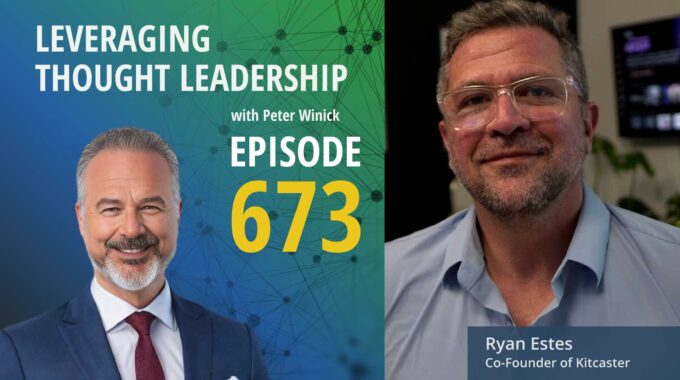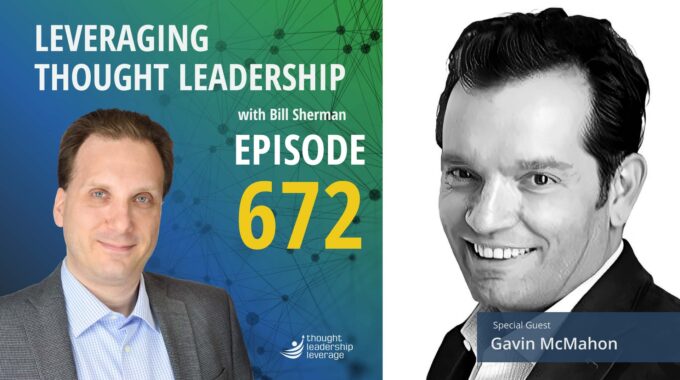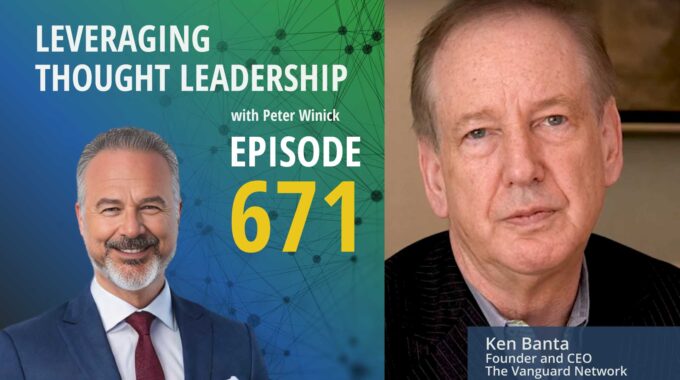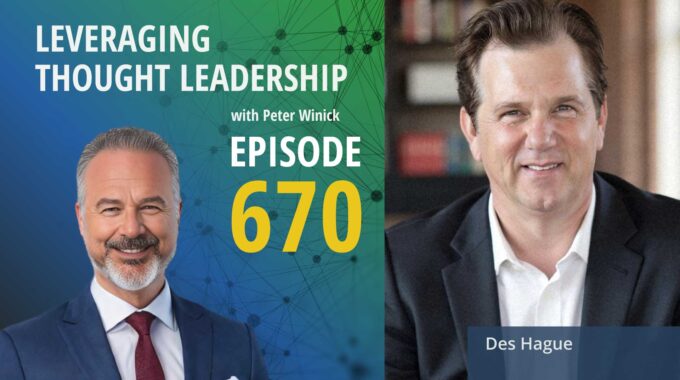Founder-led marketing, podcast strategy, and the art of authentic conversation What makes a podcast truly…
Experimentation with Platform and Content | Kevin Eikenberry
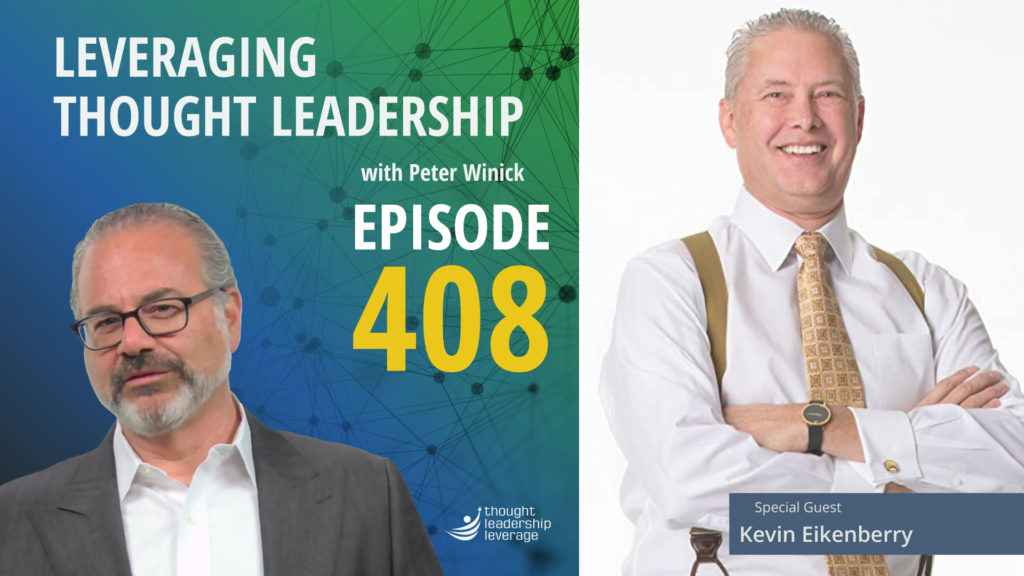
Testing new platforms and content to keep pace with your audience.
An interview with Kevin Eikenberry about adapting and growing with technology and the needs of your audience.
While many things in Thought Leadership have changed over the years, one constant is the appreciation of a great subject matter expert. But how do we find those experts?
To examine modern methods of developing a reputation and gaining the trust of your audience, we’ve invited Kevin Eikenberry, Chief Potential Officer at The Kevin Eikenberry Group, a leadership and learning consulting company. He’s also the best-selling author of Remarkable Leadership: Unleashing Your Leadership Potential One Skill at a Time and The Long-Distance Leader: Rules for a Remarkable Remote Leadership.
When Kevin started as a speaker and consultant, thought leaders had far less options for building a platform. You could make a website, start blogging, or pay a PR firm to get your name out there – but those methods are outdated, and lack greater appeal. Modern social media offers an almost overwhelming number of options, and it’s smart to utilize many different platforms to get the word out about your content.
Kevin discusses the platforms he prefers, and why he’s open to experimenting on new platforms. Not every platform will be the right fit, and Kevin explains how he repurposes content during his platform experiments to keep both the time and financial cost relatively low.
Being on a new platform only has value if your ideal audience can be found there, and if you give them content specific to their needs. Although every thought leader has their preferred method of producing content, it’s important to be able to discern whether your standard method isn’t your audience’s preferred medium. Kevin discusses his methods of finding out what the audience wants, and valuing the consumer’s interests and needs – even if they aren’t currently ready to buy.
If you want a better understanding of the way a strong platform can elevate your mission and create commercial success, this conversation has tons of insights for you!
Three Key Takeaways:
- In order to make experiments with new platforms have value, be certain that your audience spends time there and will see your content.
- Repurposing content for different platforms and mediums is a great way to save time and money.
- In order to find success, you have to manage some level of commercial expertise. Your audience needs to keep your content top-of-mind!
If you need a strategy to bring your thought leadership to market, Thought Leadership Leverage can assist you! Contact us for more information. In addition, we can help you implement marketing, research, and sales. Let us help you so you can devote yourself to what you do best.
Transcript
Peter Winick And welcome, welcome, welcome. This is Peter Winick. I’m the founder and CEO of Thought Leadership Leverage, and you’re joining us on the podcast today, which is Leveraging Thought Leadership. Today, my guest is Kevin Eikenberry. Kevin is a world renowned leadership expert, a two time bestselling author, a speaker, a consultant, a coach, a leader, a learner, a husband and father. And as he says in his bio, not necessarily in that order. And let’s just dove in. So welcome, Kevin. I’ve been a I feel like this is like the old school, Larry King, like longtime listener, first time caller for me because I’ve been on time. So thank you for taking some time to chat with us today.
Kevin Eikenberry Well, Peter, I’m glad to. And it’s a pleasure to be with you.
Peter Winick So you’ve been at this game of thought leadership, this business of thought leadership for quite some time. So I thought I would start by just sort of asking a couple of observations that you had around what’s changed and what hasn’t over the last 20 plus years that you’ve been at this.
Kevin Eikenberry Well, I don’t know that when I started that I could have put those two words. I know the word thought and I know the word leadership, but I don’t know what I would have put them together. So, you know, I don’t think while the need or the desire to build credibility, influence, etc., all the things that we think of as thought leadership existed then. I didn’t think about them in that way. Here’s what’s not change. Human behavior, right. The desire and need for people to have people that they say that’s my go to person on that topic or in that area like that. Has it changed? What has changed is the. Number of options that we have to build our platform, the number of ways that we can go about doing it and the complexity that comes with that for us who are trying to build.
Peter Winick But that’s good and bad. Stay there for a moment because that’s really good and bad. Right. So there were some old school pull them formulas, if you will, that worked fairly well. Write a book every 18 months. You know, be a keynote speaker. Check the box. Check the box. The complexities are also opportunities. Now, for a thought leader to be successful commercially, you have to understand the nuances of social media. You have to understand a wide variety of modalities and formats that your client base might want. So although on the one hand it’s more complex, you know, the other side of it, it’s gives you far, many more doors that can be open for folks to access you.
Kevin Eikenberry 100% and gives you more doors to open that can be opened. And quite honestly, if you’re willing to do that learning and let’s face it, do that work, it’s a lot cheaper, right? I mean, 30 approaching 30 years ago when I left corporate America and started doing this kind of this kind of work in general, you know, you wanted to build a platform, you know, to go hire a big PR firm. And then they were going to charge me what I made a year. Right. And, and so.
Peter Winick Even grown up a website was 30 grand, right? Like so.
Kevin Eikenberry So I never meant that much, but at least not then. But yeah, but, but yes. And you know, and I had a website in 1994 or yeah, by 1984 we had our first website and you know, I had my first blog. I don’t remember when I’d have to go back and think about that, but it’s a long time. And so I used to say to people all the time, like, If you don’t have a blog, why not start today? Right? But now that list is not just a blog like, okay, I could give you a list of all the stuff we’re doing and it’s a long darn list. And I know not everyone that’s, that’s trying to build thought leadership is using all of those tools. And there’s probably tools that, you know, we’re not using. We’re not in clubhouse, we’re not in discord and those sorts of things. But there’s an awful lot of places that we are.
Peter Winick Peter And stay with the places that you’re not. Because I find that this is a an area that people stress out over. And it’s it causes a lot of angst for thought leaders. Right. So to me, just because there’s something new doesn’t mean you need to be the proverbial first kid on the block with it. I always look at it and say, Wait a minute, time out. There’s a strategy in place. There’s a certain type of client or customer we’re looking to attract and based on their psychographic, demographics, data, etc., we can then make some semi intelligent decisions as to where they are. Right? Do you need to be on TikTok, Instagram, clubhouse, whatever? And it has nothing to do with what your personal desires are, right? So for us, we’re not on tick tock because you know, I’m on tick tock because I think it’s mildly amusing when I have 5 minutes to totally waste between calls or something. But I’ve come to the, you know, determination that this is not where my clients are hanging out, looking for insights around how to support their thought leadership. So there are so let’s.
Kevin Eikenberry Just stay there for a second. So as of about three weeks ago, as we record this, I have a tick tock account.
Peter Winick Okay.
Kevin Eikenberry And so let me just I mean, I think it’s very relevant to this conversation now when we say does it mean that makes it right or that we’ve learned anything necessarily. But let me walk you through that. Like, I’m not going to be on tick tock. I’m not going to be in tick tock. I know I’m going to go to tick tock. That was where Kevin was, right? All of that. He knew that. Then I started having clients. I mean, we’re using tick tock. To share bursts of stuff to support the training we’re doing. I’m like, Really? That was the first thought. So my first thought was, there no way my customers are there or our perfect customers are there. Then I’m like, Well, they’re a pretty perfect customer, okay.
Peter Winick But I’m totally fine with that. I am happy to be wrong any day of the week.
Kevin Eikenberry Right. Yeah. But let me go on with my thinking because I mean, you know. Okay. So I put two up this weekend. We’re having a conversation, this conversation on Valentine’s Day, right? So we decided, okay, let’s do three videos because I’ve written a bunch of stuff in the past about the connection between love and leadership and all that stuff. So let me do three and see if we can leverage Valentine’s Day. Right. So what we went out on Saturday. One went out on Sunday. One went out today. Now, we have no data about the one today. I have no idea what will happen with the other two, but about 800 views of the other two over the weekend. Now, what does that mean? We didn’t mean anything, really. But here’s why we did this or why we’re trying it, I guess, is what I should say is that it’s we’re not just doing TikTok, we’re doing short video. So most of these are getting used in Instagram as reels. They’re getting posted natively. Okay, all of them. But some of them are getting posted natively to LinkedIn and to Facebook and places where we’re using Facebook inside of inside of groups and stuff. And the other thing is we’re take we’re repurposing other content like from podcasts and stuff in short bursts and putting on TikTok. So we’re going to try all this and it doesn’t all of it require more of Kevin’s time, but it’s a chance for us to curate some other content. So we’re in experimental mode there, but we have chosen to not experiment every place. It just and it was an ego trip.
Peter Winick But I love the fact that you can repurpose it. I love the mindset of the experimenter because we do that all the time. So, for example, a year, maybe a year and a half ago, we experimented with Clubhouse of I’d never seen anything like Clubhouse in terms of how quickly everybody was on it. And you know, to me it feels like a it’s a bit of a sugar high where everyone’s crashed and what’s left is a lot of, let’s call it opportunistic multilevel. It’s not it’s not my jam for me. The brothers, no judgment like to me I’m agnostic of anything will get us or our clients the outcome or the results that they’re looking for. You know, it’s all about the experimental mindset. So you’re looking at this going, okay, well, you didn’t take 80% of your marketing budget, throw it there. You’re like, okay, little experiment, 5%, whatever, tried for a couple of months. Watch the data. I mean, you mentioned 800 views. Now we know the 800 used right now at this moment in time doesn’t mean anything. But you can now track the 800 reviews plus a bunch of other data. And in 30, 45, 60 days, say, wow, you know, this is really interesting. The next question would be, it’s interesting and it’s good for the business, right? Or not? And if not, well, but he died.
Kevin Eikenberry And I think the. Yeah, exactly. But the other thing I think that goes with this at least is we talked about various modalities. Peter And I think the key for us is to say how do we leverage across so that we’ve got, you know, we’re fortunate, we’re blessed to have a lot of loyal fans, some of whom pay us and some of them don’t yet. But but, you know, so what we’ll do is in my daily email, which comes out five days a week, not seven days a week, not that crazy. But so like last Friday, even though we’ve been on Tic TAC note for a while, we posted that, hey, we’re now do it if you like short video. Here’s where you can watch it here, here and here, including tic tac. I’m always of the belief that if people view you as a thought leader, then they want to. If they want to have access to you in a different way, then give them that chance. So if I tell them that and they go, they’re great, and if they don’t know, who cares? But if it gives people another way to access us, well, you have an.
Peter Winick Obligation to do.
Kevin Eikenberry Don’t feel like. And they’re everywhere. Yep.
Peter Winick If you’re enjoying this episode of Leveraging Thought Leadership, please make sure to subscribe. If you’d like to help spread the word about our podcast, please leave us a review and share it with your friends. We’re available on Apple Podcasts and on all major listening apps as well as at ThoughtLeadershipLeverage.com/podcasts.
Peter Winick No, and I am in a violent agreement of that. And I think what happens for many is we have a call it a content creator, bias, whatever that means. I just made that up, right? It could be Kevin likes video. It could be Kevin likes to write, it could be Peter’s visual, Mike’s info, and whatever you like, you assume the rest of the world like you because you’re perfect. So why wouldn’t you write? And you know, I’m someone that still reads two business books a week. That’s abnormal, right? That is not the market.
Kevin Eikenberry That is abnormal, Peter. Just saying, yeah.
Peter Winick Yeah, that’s the quote. Let’s pull that quote. “Abnormal Peter,” said Kevin. But no, but then, but what that, what I, I’m self-aware enough to realize, okay, I. Can’t extrapolate from my individual quirks, behaviors, whatever, what the market is. Because if I did that, you know, I would get, you know, the book sale universe is probably 100 times what it is today. So, I think you have to be aware, where am I normal? Where am I not normal? Doesn’t matter what you do unless you are your client profile. Like I would argue, Kevin, you or I may or may not be our own client.
Kevin Eikenberry Avatar No, almost, almost assuredly not. We talk about on our team all the time, like we got to remember, we’re not our customer.
Peter Winick And I think that’s the big you know, I love the way you frame that because it’s so easy to assume that we are because we want to help people. We want to get the work out there. We want to do it. We’re so passionate about what we do. And you have to say, you know, I always say there’s a difference also between the user and the buyer. Right. So, you know, not every person that goes through, you know, an Eikenberry program is a raving fan. Some have been volun told to do that. And you have to understand the difference between people opting in, you know, someone buying a book with their own money. They voted with their dollars, someone in an organization that was told, you know, hey, Peter, Tuesday at 2:00, you got to do this thing. Different behavior by you know, mindset well and you.
Kevin Eikenberry Know we do a free webinar which when last a couple weeks ago and you know we’re going to have fans that show up. We have we have fans that have checkbooks and credit cards and only do we have fans that don’t. And we’re happy to have both. Our job on the sales side is to separate is figure out who’s who. Right. But we want to build that. We want to I mean, thought leadership isn’t about only those people that have credit card debt. I think it’s.
Peter Winick Critical. So I would venture to say that your marketing people are wise enough to realize when you have a hypothesis and you want to survey, you don’t survey all of the webinar participants because you kind of don’t care. You do care, but you don’t from a marketing spend perspective, those folks that come in that don’t buy listen, if they want to consume your information and attend a free webinar, God bless. That’s great. Right. But those that have, you know, the checkbooks or the credit card, you need to you know, they’re far more important to you as a viable, healthy business.
Kevin Eikenberry Even better if they have a pin – oh – pin number. But but but the point to point with point is that what we try to do with those fans, raving fans, if you will, that aren’t a decision maker is, you know, when they engage with us, that is how can they help us get to a decision maker, right. So on the sales side, we’re still trying to we value them because our mission is to help as many leaders as we can make as big a positive difference in the world as we can. Right? Like that’s what we’re here to do. And so that doesn’t mean that if you don’t have a checkbook, we don’t want to talk to you. But what we know is we have to not only meet that purpose, but create profit. Right? We need to not only have missional success, but commercial success. That’s how I like to talk, you.
Peter Winick No, no, no, and so I –
Kevin Eikenberry Have to think about both. And so where does – back to our TikTok example because that’s sort of where we started. Where does that fit in? Who knows? It probably already is fitting into the missional part. The real question is, is it important enough to the commercial part stay because we have so many choices.
Peter Winick Well, that’s right. Well, you have choices. So the rub is you have, in essence, unlimited choices. But like everybody else, you have limited resources, time, energy, effort, money, right. So you can’t afford to spend 90% of the organization’s resources serving the missionary folks. Right. You know, the mission driven folks, because you’d be bankrupt quickly. Maybe that may be the right number for you is 5%, maybe 20%, whatever it is. Right. That’s an ongoing experiment. And you also get not just intrinsic benefit and value from that, but good things also come from someone today that’s a non buyer. There’s a lot of thought leaders that have done really well by planting the seeds and consistently supporting the communities that can’t support them now because then they move on. They, you know, one of the beauties of, you know, being at a game for a long time, being in the business a long time is, oh, hey, you know, now it’s ten years later and I do have a budget. I like Eikenberry’s work. And I have.
Kevin Eikenberry Been following you forever, Kevin. And now I’m finally in a place, right? Some of the best words, right? I’ve been following you forever, Kevin. And now I’m at a place where I can hire you. Like.
Peter Winick Who wrote that to me is. Is such a critical thought, because we get that all the time, and we support our clients to get those thoughts all the time, where if you can push out in a cost effective, scalable way, high quality thought leadership, that’s representative of what you do to certain avatars, be they buyers today or not. That will absolutely 1,000% happen. Do we know if it’ll happen in a week? No, but it will absolutely happen. And when they do come to you with those beautiful words of Kevin, I’ve been following you a long time. I don’t know what your numbers are, but in our experience, it’s over 90% that they’re in. They’re in a buy mode and they’ve already eliminated all the competition. Oh, yeah, Pletcher, maybe they’re quoting you back to you.
Kevin Eikenberry Here’s the thing. To me, I mean, outside of the fact that that I’m hoping and trying and strive to be a leader from the perspective of how it can make a difference for other people. Missional If you want to look at purpose and look at that, outside of that, the way I look at it is this like there are a lot of people that help people be better leaders. We’ll just say it that way, right? Lots of people. You’ve had other people on your show. That do that people that I follow know, respect and all that stuff. Point is, we don’t want people to come to us saying we’re looking for leadership development help. We want people come coming to say, We want Kevin. Because then there’s no competition and then there’s also less price pressure.
Peter Winick Right? No. And that’s such an amazing thought because the I’ve been following you forever is the Holy Grail. The flip side of that coin is you’ve been invited to participate in an RFP. Oh, God. Right. Like where? You know, you have no idea what their motivations are. They just fishing for information. It’s going to be a huge cost of time, energy, effort, etc.. So I think, you know, if you want to stay away from the RFP camp, which what I would I would argue that one should most of the time in most circumstances and move to the I’ve been following you forever category that’s being a long term investor in yourself and in your business and in the communities that matter to you.
Kevin Eikenberry So I don’t know how else to think about thought leadership then other than the long game. Maybe I’m wrong there, but that’s how I think about it.
Peter Winick Yeah. No, I, you know, I’m tired of violently agreeing with you, Kevin, and we have to find something we don’t like. Maybe do. How do you feel about kale? Are you a kale guy or. No? Okay, I like kale. So now we can argue about that later. That’ll be episode two. But I. But I think that long game is important because, you know, when you look at the mindset, the marketing, etc., in the B2C world, which is not where I play or my clients play, it’s a short-term mentality. You know, they thinking, Can I have to send out this campaign and do the SEO? And I’m going to send out a billion emails and x many will convert and get it out and take out your credit card. Now that sort of pressure, psychology, strategy and tactics, I find them a little gross, for lack of a better word. But they more importantly or as importantly, they just don’t work for real followers. It is not the way to win the game.
Kevin Eikenberry Well, I mean, I’m of the opinion that one is the most dangerous number in business. Right. And so we had this conversation about what platform are you on and what are you doing? And so that’s why I said, Well, do I want to do Tik Tok? Well, if I can leverage that to four other places. So one is a dangerous number. So we do send what I would call marketing emails and sometimes what you would probably call a sales email. And I’d like to think they’re not gross. But I guess what I’m saying is that we believe that we want to become and we’re working hard every day to become thought leaders and we’re trying to sell stuff to not only to the people that have known as for ever, but from the people that have started to know who we are. We picked their interest up. And now it’s time right now. And I’m not saying that we’re disagreeing, but I think there’s a there’s a, oh, I don’t want to do this or I won’t do that again. It goes back to who’s the customer, right? And sometimes we have to figure out how to get their attention right now because now they’re buying. Everybody’s got a car. Well, my daughter does it because she’s moving to Metropolitan downtown Minneapolis. But. Right. But look, but there’s a.
Peter Winick Nuance there that’s important, Kevin, in that. Your mindset is the long game, which is the correct mindset in my humble opinion. However, it doesn’t mean that you wouldn’t have campaigns going out that have a short-term objective on it. I totally agree. There is a time and place for that. And there’s, you know, there’s a bunch of research done, you know, give ten times, ask ones. I mean, there’s a lot of work that you can study and research that what I’m talking about is sort of this B2C mentality where they’re constantly hammering you with buy, buy, buy, buy, and it is so disgustingly transactional that you wouldn’t want to have a long-term relationship with those folks. Because, you know, the struggle for thought leaders, as we always theoretically have the supply. We don’t know when the demand comes on the client side that’s beyond our control. So our job is to be aware, is to keep that level of awareness high and the engagement high so that when and if a subset come into buy mode, they’re calling you up and going, Kevin, I’ve been following you forever and I really dig your stuff. And now I’ve got this team of 100.
Kevin Eikenberry Right. Or the time has been right now the time is right.
Peter Winick Or whatever it is, whatever it is. Yeah, yeah, yeah. Well, this has been great and I really, number one, have appreciated your work from afar for a long, long time. So it’s always fun to talk to someone that feels this is the same theory, sort of feels like an old friend because I read all your stuff and sort of have a sense of what I’m coming into. And you know, with regard to today, it was fun to violently agree with you except for the kill issue, and I can let that go.
Kevin Eikenberry Well, I’m sure we could probably find something else we don’t agree on, but I think that for the stuff that we’re talking about today, I’m happy to find that I’m talking to an expert here and he’s saying, hey, you got some of this, right, Kevin? And so this was really useful for me and valuable for me and fun for me. So thanks for having me on. We had this conversation before that. A number of your past guests are people that I know and or sometimes and sometimes or respect because I don’t know them. Right. But and so it’s an honor to have been on. And so thank you.
Peter Winick A pleasure to have you. My pleasure. Thank you so much, Kevin.
Peter Winick To learn more about Thought Leadership Leverage. Please visit our website at Thought Leadership Leverage dot com. To reach me directly, feel free to email me at Peter at ThoughtLeadershipLeverage.com, and please subscribe to Leveraging Thought Leadership on iTunes or your favorite podcast app to get your weekly episode automatically.



